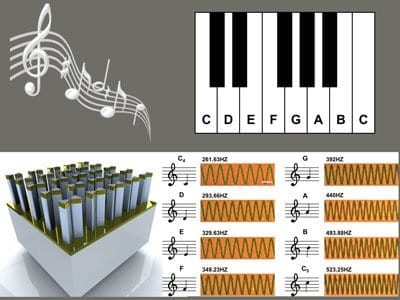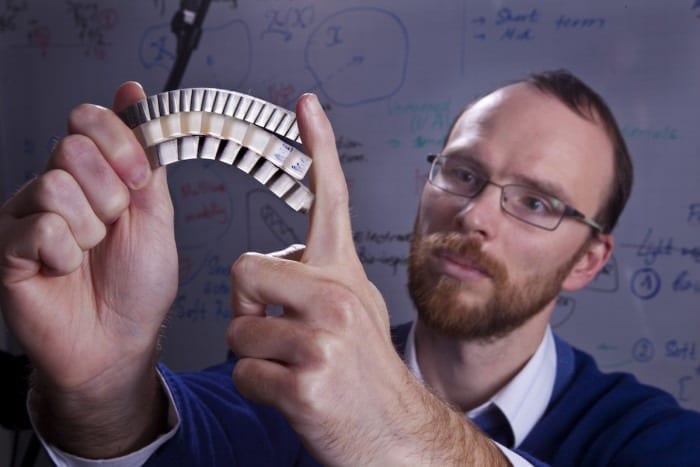
Researchers from the Univ. of Illinois at Urbana-Champaign have demonstrated the first-ever recording of optically encoded audio onto a non-magnetic plasmonic nanostructure, opening the door to multiple uses in informational processing and archival storage.
“The chip’s dimensions are roughly equivalent to the thickness of human hair,” explained Kimani Toussaint, an associate professor of mechanical science and engineering, who led the research.
Specifically, the photographic film property exhibited by an array of novel gold, pillar-supported bowtie nanoantennas (pBNAs)—previously discovered by Toussaint’s group—was exploited to store sound and audio files. Compared with the conventional magnetic film for analog data storage, the storage capacity of pBNAs is around 5,600 times larger, indicating a vast array of potential storage uses.
To demonstrate its abilities to store sound and audio files, the researchers created a musical keyboard or “nano piano,” using the available notes to play the short song, “Twinkle, Twinkle, Little Star.”
“Data storage is one interesting area to think about,” Toussaint said. “For example, one can consider applying this type of nanotechnology to enhancing the niche, but still important, analog technology used in the area of archival storage such as using microfiche. In addition, our work holds potential for on-chip, plasmonic-based information processing.”
The researchers demonstrated that the pBNAs could be used to store sound information either as a temporally varying intensity waveform or a frequency varying intensity waveform. Eight basic musical notes, including middle C, D and E, were stored on a pBNA chip and then retrieved and played back in a desired order to make a tune.
“A characteristic property of plasmonics is the spectrum,” said Hao Chen, a former postdoctoral researcher in Toussaint’s PROBE laboratory and the first author of the paper appearing in Scientific Reports. “Originating from a plasmon-induced thermal effect, well-controlled nanoscale morphological changes allow as much as a 100-nm spectral shift from the nanoantennas. By employing this spectral degree-of-freedom as an amplitude coordinate, the storage capacity can be improved. Moreover, although our audio recording focused on analog data storage, in principle it is still possible to transform to digital data storage by having each bowtie serve as a unit bit 1 or 0. By modifying the size of the bowtie, it’s feasible to further improve the storage capacity.”
Read more: Nano piano’s lullaby could mean storage breakthrough
The Latest on: Data Storage
[google_news title=”” keyword=”Data Storage” num_posts=”10″ blurb_length=”0″ show_thumb=”left”]
via Google News
The Latest on: Data Storage
- Panasas Is Now VDURA for AI and HPC Data Storageon May 7, 2024 at 1:12 pm
Long-time HPC data storage company Panasas (formed 1999) is now Vdura. The new brand "signifies the company’s shift to a software company operating under a software subscription-based business model," ...
- Panasas Rebrands as VDURA: A New Chapter in Software-Defined Storage for AI Applicationson May 7, 2024 at 12:50 pm
VDURA, the AI and HPC data infrastructure software company, today announced its official launch as the new brand identity ...
- Huawei sees future in data storage businesson May 7, 2024 at 8:26 am
Huawei’s president of European enterprise Willi Song and president of IT product line Peter Zhou outlined ambitions for its data storage enterprise.
- Dallas company plans $1.6 billion data center complex near Benbrookon May 7, 2024 at 8:16 am
Fort Worth, not lacking the vast expanses of land needed to house the massive depots, has attempted to position itself as a hub for data storage.
- 3 Storage Devices Stocks to Watch as the Industry Reboundson May 7, 2024 at 8:16 am
The Zacks Computer-Storage Devices industry players are well-poised to gain from solid momentum in cloud computing, Internet of Things (IoT), auto, connected devices, virtual reality and Artificial ...
- Panasas becomes VDURA as it Rewrites the Rules for AI and HPC Data Storageon May 7, 2024 at 5:59 am
VDURA, the AI and HPC data infrastructure software company, today announced its official launch as the new brand identity of Panasas, longtime HPC and parallel file system pioneer. The rebranding ...
- TerraMaster D8 4-bay Hybrid NAS storage combines SSD and HDDon May 7, 2024 at 3:50 am
TerraMaster has launched its new D8 Hybrid network attached storage solution in the form of a new hybrid NAS that combines both SSD and HDD ...
- Balancing Virginia’s energy future: A holistic approach to powering data centerson May 7, 2024 at 3:18 am
Virginia, home to the country’s largest concentration of data centers, faces a critical juncture in its energy future. As the demand for data storage and processing grows, so does the need for ...
- The impact of edge computing on data storage architectureon May 7, 2024 at 12:08 am
E dge computing has come to light as a transformative technology in the scope of data storage architecture, presenting innovative solutions to tackle the challenges caused by the ...
- MeriTalk and Hitachi Vantara Federal Unveil Federal Data Maturity Report: A Roadmap for Optimizing Storage, Operations, and Insightson May 6, 2024 at 6:00 am
Ninety-nine percent of Federal IT decision-makers say their agencies have put a greater emphasis on leveraging data to drive decision-making and achieve mission goals in the past year, according to ...
via Bing News










